Dynasty of Ruin: The crash of China Airlines flight 676
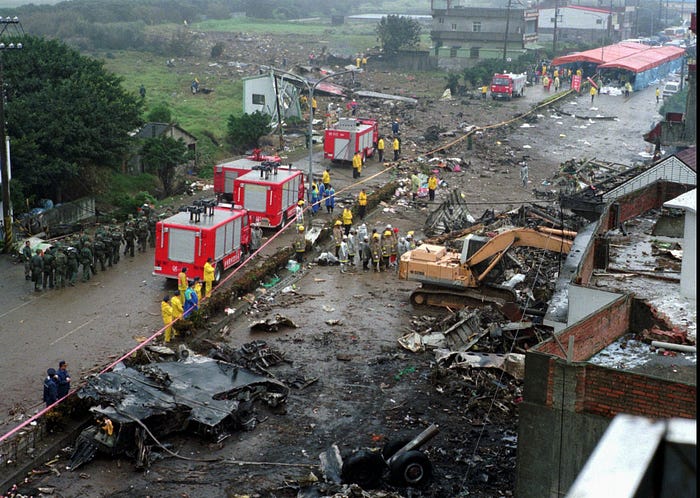
On the 16th of February 1998, a China Airlines Airbus A300 was on final approach to Taipei, Taiwan when the pilots realized they were coming in too high. The captain decided to execute a go-around, climbing away to return to the beginning of the pattern to try again. But within seconds, something went catastrophically wrong: the plane pitched up steeply, stalled, and fell from the sky as the pilots fought for control. The fully loaded jet slammed into a residential street adjacent to the runway, sending flaming debris ripping through a row of two-story townhouses. The devastating crash killed all 196 passengers and crew along with seven people on the ground. But the most remarkable thing about the crash was a chilling sense of de ja vu: less than four years earlier, another China Airlines Airbus A300 crashed while attempting a go-around in Nagoya, Japan, killing 264 people. Everyone wanted to know: what had gone wrong this time? Why hadn’t China Airlines learned its lesson from this previous disaster? And how many people would have to die before something fundamentally changed?

China Airlines is the state-owned flag carrier of Taiwan, also known as the Republic of China. Its reputation is fairly strong today, but this was not always the case: for more than four decades after its founding in 1959, it suffered an astonishing accident rate that made it something of an international pariah. In 1985, a China Airlines Boeing 747 fell 30,000 feet over the Pacific after the pilots lost control during cruise, injuring dozens of people. In 1986 a 737 was lost with all 53 passengers and crew; in 1991 a 747 cargo plane went down with the loss of all hands; in 1992 a passenger 747 was written off after sliding into Hong Kong bay on landing; and in 1994, in the airline’s worst accident yet, an Airbus A300 crashed while trying to land in Nagoya, Japan, killing 264 of the 271 people on board — one of the deadliest plane crashes in Asia. After that accident, China Airlines’ entire slate of executives resigned, and foreign experts were brought in to try to turn the situation around.

By February 1998, China Airlines had so far avoided any further accidents, but four years was not enough time to prove that improvements had really occurred. Little did the people of Taiwan know that some of the worst was yet to come.
On the 16th of February that year, Captain Kang Long-Lin and First Officer Jiang Der-Sheng suited up to fly China Airlines flight 676, a regularly scheduled service from Denpasar on the Indonesian resort island of Bali back to Taipei, Taiwan’s capital city. The plane they would be flying was an Airbus A300, the first model Airbus ever produced and the world’s first twin-engine, wide body jet. Although this particular plane was only eight years old, by 1998 the A300 was not particularly technologically advanced. It predated Airbus’s introduction of fly-by-wire technology and flight envelope protections, so in most respects it flew just like conventional jets by Boeing and McDonnell Douglas. Captain Kang had been flying the A300 for several years, accumulating over 2,300 hours on the type — a significant contrast to First Officer Jiang, who was not inexperienced but had only recently transitioned to the A300 and had just 304 hours on the new airplane.
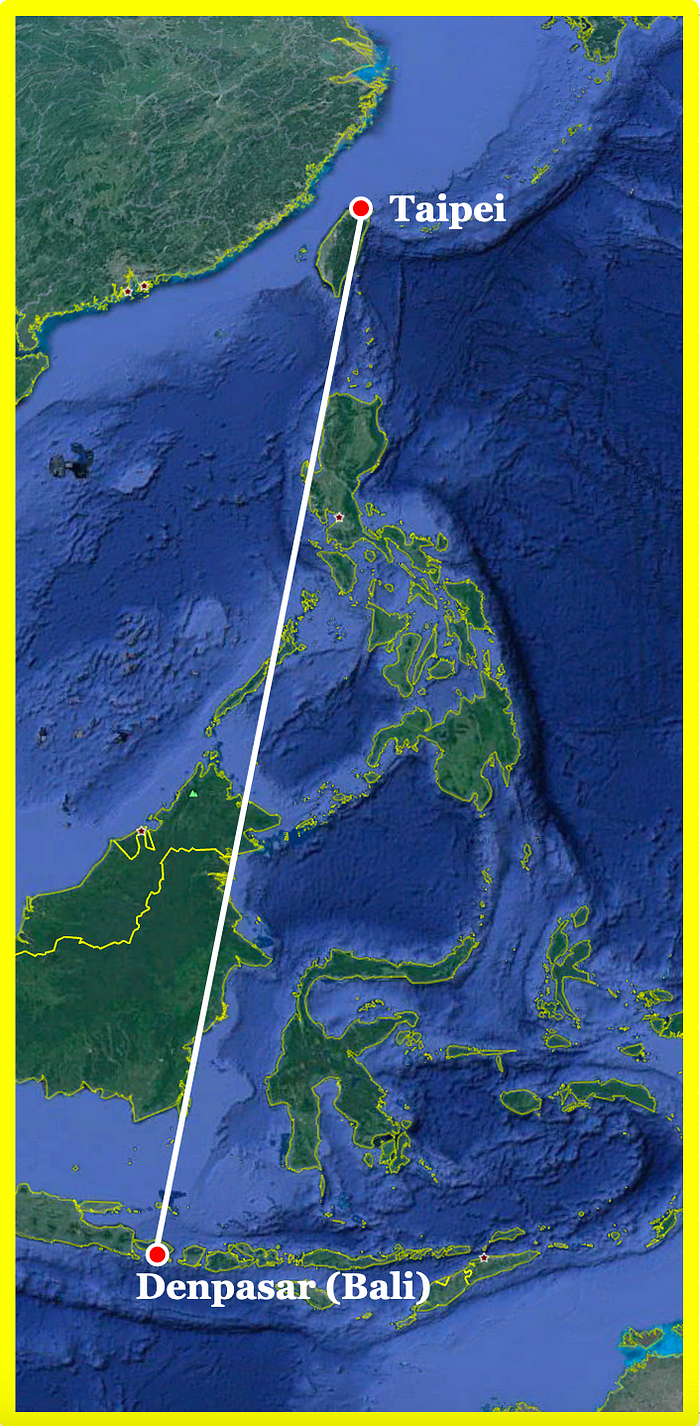
With 182 passengers and 14 crew on board, China Airlines flight 676 departed Bali at 3:27 p.m., headed north toward Taiwan. But by the time flight 676 drew near to the island several hours later, night had fallen, and bad weather was rolling over Taipei’s Chiang Kai-Shek International Airport. Fog reduced visibility to 1300 meters with a broken ceiling just 100 feet above the ground. Nearby, thunderstorms dumped rain over the city and lightning flashed between the clouds. The pilots tuned in to the airport’s Automated Terminal Information Service, or ATIS, to receive the details: visibility was bad, and trending downward.
With the visibility worsening, Captain Kang was eager to get on the ground as quickly as possible, while the conditions were still above the minimums for landing. At 7:35 p.m., still in cruise off the coast of Taiwan, First Officer Jiang informed the rest of the crew that they would begin their descent in seven minutes. But in what would prove to be the initiating factor in an escalating sequence of errors, Captain Kang didn’t instruct First Officer Jiang to request descent clearance until ten minutes later, three minutes after they had calculated they would need to leave their cruising altitude. As a result, flight 676 would need to lose the same amount of altitude over a shorter distance.
As the plane descended toward 25,000 feet, the cockpit voice recorder picked up conversations which set the tone for all further interactions between the pilots. At 7:45, Captain Kang instructed First Officer Jiang to contact China Airlines’ operations center and ask for their gate assignment. But just seconds later, he changed his mind, deciding that Jiang’s time would be better used preparing for an expedited descent. Jiang tried to call operations anyway — but he forgot to change the radio frequency, so he accidentally said, “Operations, Dynasty 676” over the general air traffic control frequency. Captain Kang jumped on the radio to tell the controller to disregard the transmission, after which Jiang switched to the correct frequency and made the call to operations, having thoroughly embarrassed himself in front of his captain and everyone else on approach to Taipei that night.
As the descent continued, Kang constantly pushed Jiang to get new descent clearances from air traffic control as quickly as possible. As the plane neared 25,000 feet, he said, “Approaching 250. Contact them immediately. Don’t write these things down. We keep on descending. We don’t want to stay here.” Jiang quickly contacted ATC, who cleared them down to 21,000 feet.
Moments later, Kang said, “This is the most important thing. You see, if we don’t descend, the visibility will be getting worse. Go back soon, it’s important. These things… these things… what are you doing!?”
“Yes. Key in this data?” Jiang said hesitantly.
“Key in?” said Kang. “Use this is okay. Just write down there, we need to be back as soon as possible. Later on, maybe we won’t be able to descend, it [ATIS] said ‘downward.’ Don’t waste too much time on these. What is the QNH? This is the most important.”
“Yes, 1014,” said Jiang, providing the barometric pressure reading at the airport.
A minute or so later, a new ATIS broadcast came over the radio, and Captain Kang said, “Now we start listening and writing!” He then added that he could see lightning off to one side of the plane, and that they would need to hurry up and land before the weather got worse.
But despite his apparent desire to expedite the descent, Captain Kang took no action to get down quicker. Because they started the descent three minutes late, they were well above the optimal descent path, and he would have needed to increase the plane’s descent rate by throttling back and deploying the speed brakes. But he only deployed the speed brakes for about one minute before retracting them, nowhere near long enough to get back on course. At the same time, he violated standard operating procedures by talking to ATC himself whenever he thought First Officer Jiang was not quick enough getting on the radio, something which happened with considerable frequency. As the pilot flying the plane, Captain Kang was supposed to leave the radio calls to his First Officer, but his trust in Jiang was apparently so low that he often took this on himself.
At 7:57, as the pilots began the approach checklist, the controller cleared them to descend to 4,000 feet, but amid the escalating workload neither pilot heard the transmission. And after finishing the approach checklist, they were supposed to cross-check their altitude and their distance from the airport, but neither pilot did this. According to the operations manual, they should have been at about 8,000 feet by this point, but they were actually at 10,000. Despite this, Captain Kang allowed their descent rate to go from -1,500 feet per minute to -800 feet per minute over the next 90 seconds, further exacerbating the problem. At 8:00, First Officer Jiang said, “Only 16 miles to the runway, currently the altitude is 7,000 feet,” probably in an attempt to get Captain Kang to realize that they were way too high. By this point they should have been at 4,000 feet. But despite being aware of their excessive height, Kang merely told Jiang to extend the flaps early in a futile attempt to increase drag and improve their descent rate. Recognizing that this would be insufficient, Jiang also extended the speed brakes without having been told to do so.

Both of these measures were in fact totally inadequate — by this point the only way to safely get down to the runway would have been to make a loop and rejoin the pattern at a lower altitude. Nevertheless, Captain Kang pressed on, extending the landing gear early to try to increase their descent rate even more. Noticing that flight 676 was clearly too high, the approach controller asked, “Dynasty 676, is it too high for you?” But there was no reply, because he didn’t manage to get the transmission in before the crew switched frequency to contact the tower.
Meanwhile on the plane, Captain Kang said, “Oh, we are high,” finally acknowledging the reality of the situation. But then he added, “Go down further, it doesn’t matter.” He then began making distance calculations out loud, and came to the conclusion that they probably couldn’t make it. Nevertheless, he did not call off the approach, apparently out of desperation to reach the runway before conditions deteriorated. At this point, they passed over the outer marker — the beginning of final approach — at a height of 3,000 feet instead of the required 1,400. “God, tailwind is too strong,” said Captain Kang, although the light tailwind they were experiencing was not the source of the problem. “Two miles,” Kang said. “Did you report? Report again.”
First Officer Jiang initially did not reply, so Kang yelled at him, “Report, report to the control tower!”
Jiang hastily called the tower and reported that they were three nautical miles (5.5km) on final, which was the correct figure (as opposed to the value of two miles given by the captain). Jiang was clearly paying attention to their position, but at no point did he advise Captain Kang that it would be impossible to make the runway.
By this point, flight 676 had still not picked up the signal from the glide slope, the equipment which would guide them at the precise angle needed to reach the runway, because they were too far above it. It was at this point that something unexpected happened: the flight director and autopilot suddenly stopped indicating that they were above the glide slope and began indicating that they were below it.

What had happened was they had strayed across a false glide slope located six degrees above the real one. A glide slope transmitter emits a directed beam at an angle of three degrees, the optimal approach angle, but due to the interference pattern used to create the signal, duplicate “lobes” also exist at six degree increments above the real glide slope. Thus false glide slopes exist at nine degrees, fifteen degrees, and so on, with alternating polarity. “Reversed polarity” means that the glide slope at nine degrees will induce a “fly down” command when below it and a “fly up” command when above it, which then returns to the correct polarity at the 15 degree glide slope. So when flight 676 strayed above the nine degree false glide slope, the plane’s instruments began receiving a “fly up” command. As a result, the autopilot moved the horizontal stabilizer toward nose up in order to climb.
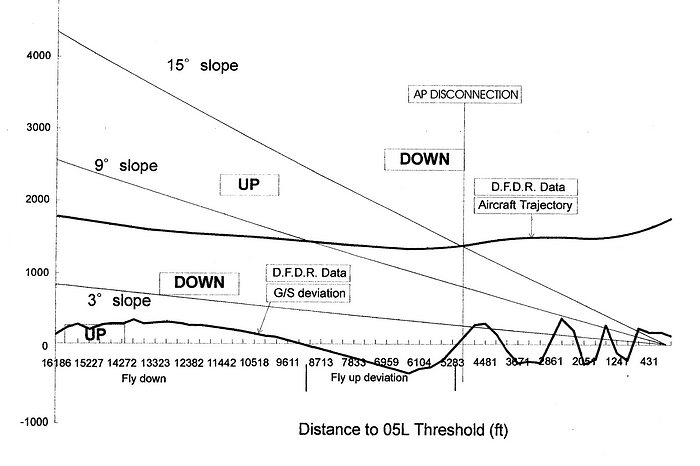
But Captain Kang was well aware that they were above the real glide slope, not below, so he responded by pushing the nose down with his control column to prevent the plane from leveling off. Now the autopilot was moving the stabilizer — which determines the resting pitch attitude of the plane — toward nose up, while Kang used the elevators to try to push the nose down.
At that moment, Kang was taking advantage of a feature of the autopilot called “supervisory override.” When the autopilot was in glide slope capture mode — that is, prior to intercepting the glide slope — the pilot is allowed to make inputs using the control column to adjust the plane’s longitudinal trajectory and intercept the glide slope more quickly. But as soon as the plane gets close to the glide slope, the autopilot switches to glide slope track mode, where it holds the plane on the three-degree glide slope and the supervisory override function is disabled. While Captain Kang attempted to push the nose down against the autopilot, the plane got close enough to the false glide slope at 15 degrees for the autopilot to switch to glide slope track mode. In this mode, pushing on the control column with sufficient force will disconnect the autopilot and return the plane to manual control. Because Kang was already applying sufficient pressure to the control column, the autopilot disconnected as soon as it entered glide slope track mode. A loud autopilot disconnect warning suddenly sounded in the cockpit, but one of the pilots quickly reached up and turned it off.
At first, Captain Kang appeared not to notice. He ticked off one last checklist item and then called “landing checklist complete,” seemingly indicating that he planned to continue. But just one second later, he changed his mind: finally acknowledging that they were much too high, he announced, “Go around!” At the same time, he swiftly reached down and pressed the go-around switches, which instruct the autopilot and autothrottle to initiate the go-around sequence and abandon the approach. Normally, pressing the go-around switches will put the autopilot in go-around mode, where it holds the pitch attitude at or below eighteen degrees to maintain a stable climb. But the autopilot had disconnected six seconds earlier, so the switch only had an effect on the autothrottle. Engine thrust automatically began to increase toward go-around power, but with the autopilot off, it was Captain Kang’s responsibility to follow the instructions on his flight director — the overlay on his main display showing him the correct angle at which to fly. But instead of taking the control of the plane, he found himself sucked into a confusing exchange with his copilot.
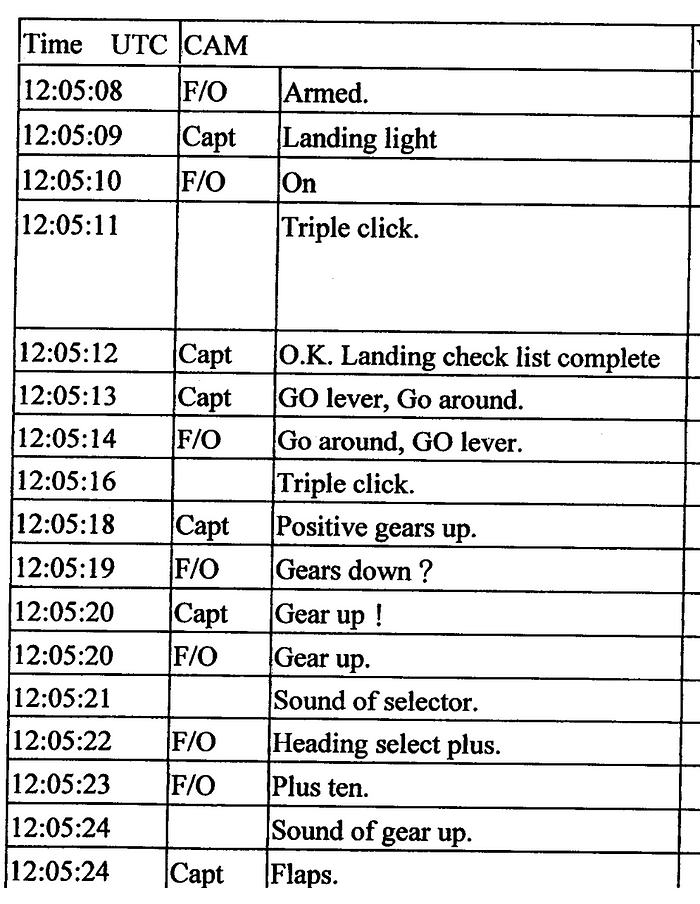
“Go lever, go around?” Jiang said, sounding confused by the sudden change of plans.
“Positive [rate], gear up,” Kang ordered.
But normally the flaps must be retracted before the landing gear during a go-around. “Gear down?” Jiang asked, sounding even more confused than before.
“Gear up!” Kang insisted.
“Gear up,” said Jiang, finally retracting the landing gear. A configuration alarm began to sound in the cockpit, indicating that they were configuring the plane out of order.
Throughout this exchange and for several seconds afterward, Captain Kang made no attempt whatsoever to take control of the plane. Without anyone working the controls, the power produced by the engines — which are mounted below the center of gravity — caused the plane to pitch up rapidly. For eleven seconds, Kang did not react to this increasing pitch. When he finally noticed the problem, the plane had already pitched up to thirty degrees, nearly twice the proper pitch angle during a go-around. He now began making some hesitant nose down inputs, but his reaction was insufficient to stop the increase in pitch, which reached an astonishing 42.5 degrees within seconds. The plane’s speed dropped precipitously, falling below 100 knots. The stick shaker stall warning activated, informing the pilots that the plane was about to fall from the sky. As the wings began to lose lift, the plane banked nearly 50 degrees to the right, reached a peak altitude of 2,751 feet above the ground, and began to fall. With a forward airspeed of just 43 knots, the A300 seemed to hang in the air for a split second before the nose dropped and the plane banked 79 degrees to the left and entered a dive. Captain Kang immediately applied the stall recovery procedure, pitching down to regain airspeed, but they were rapidly running out of altitude.
In a panic, First Officer Jiang keyed his mic and said to air traffic control, “676, Tower, Dynasty — ”
“Dynasty 676, confirm go around?” asked the tower. There was no reply.
Inside the cockpit, warnings blared as the plane plunged toward the ground. “TERRAIN,” said the ground proximity warning system. “WHOOP WHOOP, PULL UP!”
Captain Kang attempted to re-engage the autopilot, but in such an unusual attitude this was impossible. The plane began to pull out of the dive, but it was clear they weren’t going to make it. “Pull up, altitude low!” shouted First Officer Jiang.
“WHOOP WHOOP, PULL UP,” said the ground proximity warning system. These were the last words on the cockpit voice recording.
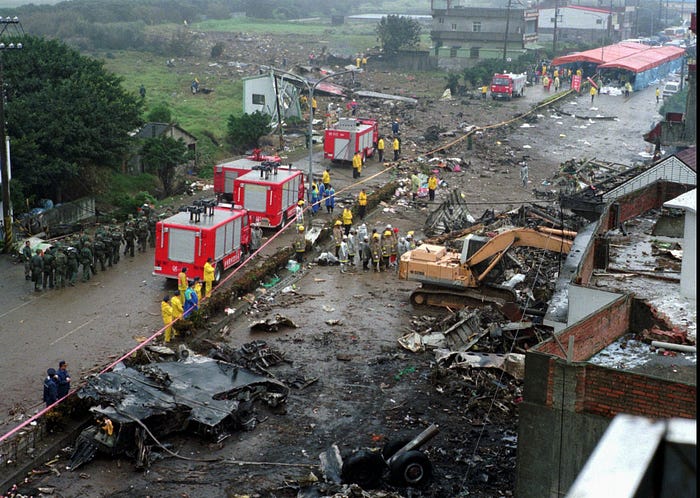
At 8:05 p.m. and 57 seconds, China Airlines flight 676 slammed into the ground just outside the airport perimeter wall to the left of runway 05L. The plane touched down in a field, slid across a four-lane road, and slammed headlong into a row of two-story townhouses. A massive explosion rocked the residential street as flaming wreckage was catapulted over the tops of the buildings; several residences collapsed into rubble on the spot. Terrified residents ran out into the street, only to be confronted with a scene of total devastation. Four multi-unit buildings had been completely destroyed and several others were severely damaged. Burning wreckage and bodies littered the streets and yards. As emergency workers rushed to the scene, they held out little hope for those on the plane: although it was reported that a child passenger was found with signs of life, they quickly died of their injuries, and no other survivors could be found. All 196 passengers and crew were dead, along with seven people on the ground. Emergency crews did manage to extract a few survivors from the collapsed buildings, including a baby found under the wreckage more than 20 minutes after the crash, but for the most part the ambulances went home empty.

Among the dead in the crash was the director of Taiwan’s national bank, along with his wife and two of his high-level officials. With the rest of the region in the midst of the late 1990s Asian financial crisis, the government moved swiftly to prevent instability in the state bank from plunging Taiwan into the same sort of financial collapse. The prime minister convened an emergency cabinet meeting and appointed a new acting director later that very same night. But with financial turmoil averted, Taiwan still had to deal with a different crisis: a crisis of confidence in the country’s flag carrier. Before the wreckage had even gone cold, Taiwan and the world had already begun to ask: how was it that China Airlines could suffer a second massive disaster with over 200 dead in less than four years? What became of the restructuring that was undertaken after the crash in Nagoya? The Taiwanese government responded by grounding all of China Airlines’ Airbus A300s, and all of the airline’s high level executives immediately resigned. But before these critical questions could receive real answers, Taiwanese investigators would need to figure out the basic sequence of events.

The escalating series of errors which led to the crash began when the pilots initiated their descent three minutes later than planned. After this, the plane was too high throughout the approach. Although the approach could have been salvaged by expediting the descent in the early stages, this was not accomplished, and the flight remained much too high all the way past the outer marker and onto final approach. The pilots knew they were too high, but Captain Kang Long-Lin refused to circle around or perform a go-around to get back on track because he was afraid that if he did so, weather conditions would deteriorate below minimums and he wouldn’t be able to land.

It was in the final minute of the flight that things truly went awry, however. Because they were too high, the plane entered an area of reversed glide slope polarity, causing the autopilot to try to fly up to intercept the glide slope instead of down. To prevent the autopilot from putting the plane into a climb, Captain Kang pushed down on the controls, fighting against the autopilot. When the autopilot entered glide slope track mode, the force he was applying on the control column was sufficient to cause the autopilot to disconnect, apparently without him being aware of it. Six seconds later, he decided to abandon the approach and initiated a go-around by pressing the go-around switch. This caused the autothrottle to accelerate the engines, resulting in a large pitch up moment which it was his responsibility to counter because the autopilot was off. However, he didn’t realize that the autopilot wasn’t in control, so he took no action. Instead, he became distracted trying to clarify his orders for his confused first officer, who was suffering from mental whiplash due to the captain’s extremely sudden decision to abandon an approach that he had seemed intent on continuing right up to the very moment he changed his mind. This untimely distraction, combined with his expectation that the autopilot would control the pitch, caused Captain Kang to miss their steep pitch angle until they were already on the brink of disaster. By the time he took decisive action, the plane was already stalling, and there wasn’t enough room to recover.

Contributing to the crash was the pilots’ poor use of crew resource management. Throughout the descent, the captain spoke to the first officer in a somewhat condescending manner, like a master to an apprentice. He displayed dissatisfaction with the first officer’s performance, on several occasions taking over his duties for him or snapping at him if he felt he wasn’t moving fast enough. First Officer Jiang also made an embarrassing error at the beginning of the approach which put him on the defensive. As a result of these factors, Jiang had little room to challenge Captain Kang’s delusional decision to press onward with the approach. Jiang was clearly aware that more needed to be done; for example, he obliquely stated that they were too high, and he deployed the speed brakes without being asked. But at no point did he attempt to tell Kang what he really thought about the situation. And even if he had, Kang’s behavior suggests that he would have been unlikely to listen. This was a classic example of an excessive authority gradient where all information flowed from the captain to the first officer, and the first officer was completely subordinate. There were two people in the cockpit of flight 676 but effectively only one brain, because the first officer’s opinions didn’t matter. This reduced the amount of information available to the captain when he was making decisions. In contrast, a crew which utilizes effective crew resource management techniques would have discussed their excessive height much earlier and come to a mutually agreeable decision as to what should be done. Such a crew also would have hashed out their plans for a go-around well in advance of having to actually do one, ensuring that both pilots were ready just in case.
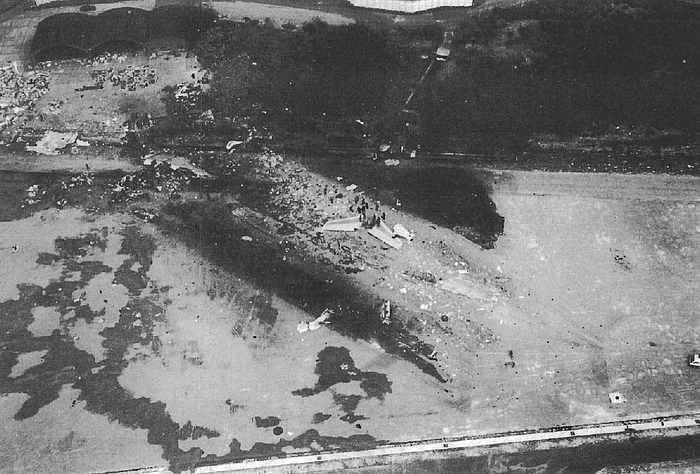
When investigators published their preliminary findings, experts and amateurs alike were struck by the similarity between the crash of flight 676 and the crash of flight 140 in Nagoya. In that accident, an Airbus A300 was on final approach to the airport when the inexperienced first officer accidentally pressed the go-around switch, putting the autopilot into go-around mode. The autopilot attempted to climb, but the captain still wanted to land, so he pushed down in an attempt to override the autopilot. The problem was that in go-around mode, pushing on the control column doesn’t disconnect the autopilot. So the autopilot, trying its hardest to climb, kept adding more and more nose up stabilizer trim — until the captain gave up and decided to just go through with the go-around. He pulled back on the controls to climb, not aware that the autopilot had already trimmed the stabilizer to nearly the maximum nose up position. This combination of inputs resulted in the plane pitching up to an extreme angle, stalling, and nosediving back down into the runway, killing 264 of the 271 passengers and crew.

After the Nagoya disaster, China Airlines’ chairman, director of flight operations, and director of safety all resigned, and the company signed a contract with Lufthansa Technik to try to knock the airline into shape. The goals of the restructuring included enhancing crews’ knowledge of aviation language, weather, and aircraft performance, and to improve crew resource management (CRM). The crash of flight 676 made it obvious that none of these measures worked. Even though Captain Kang had undergone initial CRM training focusing on cockpit cooperation strategies, he hadn’t received any follow-up training in the years since, and it was clear that the session had little impact on his working philosophy. Investigators who examined China Airlines’ training program also wrote that little appeared to have changed since the Nagoya crash — sure, some new concepts had been introduced and some personnel swapped around — but nothing was fundamentally different.
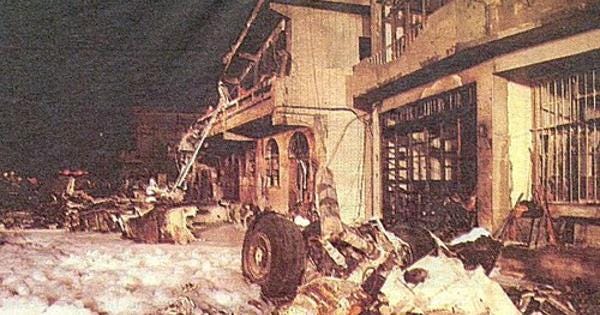
In the opinion of many experts, the problem with China Airlines wasn’t mysterious, nor was it “Asian hierarchical values” as many have tried to claim since, nor even (as CNN spuriously insinuated) the fact that it operated Airbus A300s. The problem lay in where it got its pilots. In the 1990s, most China Airlines pilots had military backgrounds, and many had spent far more time flying in the military than in the civilian industry. (Indeed, both pilots of flight 676 used to fly for the Taiwanese Air Force.) In much of the world, revolving doors between the military and commercial airlines are deliberately avoided because military culture includes values which are incompatible with the modern techniques that make civil aviation so safe. A strong command structure led by an unquestionable authority figure is one thing when under enemy fire, and quite another when trying to land at Chiang Kai-Shek International Airport during a storm with 196 passengers and crew on board. Korean Air notably suffered from the same problem at around the same time. Both South Korea and Taiwan had only recently come out of decades of dictatorship in the wake of devastating wars, and in both countries the military was afforded utmost respect. As a result, pilots who achieved high rank in the air force tended to be given the rank of captain right away, even if they had no civilian experience, simply out of deference to their former high status. At China Airlines, this got in the way of efforts to adopt modern CRM techniques, which required experienced captains to work together with and consider the opinions of first officers who they tended to view the same way an officer viewed his subordinates.
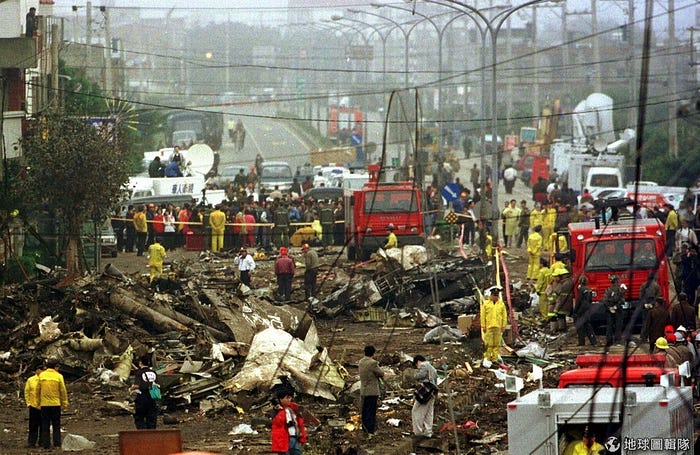
To make matters worse, 71.5% of China Airlines was owned by a nominally government-run board called the China Airlines Foundation, which in practice received no government oversight and was immune to lawsuits. The China Airlines Foundation had pursued a policy of profit at all costs and was deeply intertwined with the former military elite who held senior pilot and management positions. After the crash, many in Taiwan called for the foundation to be disbanded immediately. Many others began boycotting the airline, causing profits to plummet. It was clear to the government that this time, something really did need to be done.
After the accident, China Airlines appointed a new chairwoman who promised to completely overhaul the company culture. The airline began severing its military connections and hired dozens of new pilots with civilian backgrounds and proven experience. An internal review group called the “special project team” was set up to identify safety problems, and it eventually submitted no less than 128 recommendations for areas that could use improvement. Among these recommendations was that China Airlines recertify all its A300 pilots to weed out those who lacked the necessary skill; during two rounds of re-testing, 13 pilots failed in the first round, 14 more failed in the second, and one failed both. The dismal results of these tests provided the cover the company needed to hire new pilots who, it was thought, would bring with them a safer attitude.

It did take some time for these changes to sink in and truly alter China Airlines’ safety culture. Its last crash due to pilot error occurred in 1999, when an MD-11 flipped over while trying to land in Hong Kong during a typhoon, killing 3 and injuring over 200. Then in 2002, China Airlines suffered its third and final massive disaster when flight 611, a Boeing 747, disintegrated in midair over the Taiwan strait, killing all 225 people on board. But the cause of that crash was traced to improper maintenance conducted all the way back in 1980. The pilots were found to have done nothing wrong.
Flight 611 was China Airlines’ last fatal accident. Nineteen years have passed since then, and the airline’s reputation has mostly recovered. The three disasters have not been forgotten by the Taiwanese people, but they have managed to forgive: any desire to boycott the airline has long since passed, and experts now consider China Airlines just as safe as other major flag carriers. Taiwan’s government has learned its lesson too: after Taiwanese regional carrier TransAsia Airways suffered two back-to-back crashes in 2014 and 2015, regulators revoked the airline’s operating certificate, and it never flew again. This time, the problem airline wouldn’t be allowed to complete the trifecta of disaster. This time there would be no second chances.
___________________________________________________________
Join the discussion of this article on Reddit!
Visit r/admiralcloudberg to read over 170 similar articles.
You can also support me on Patreon.
